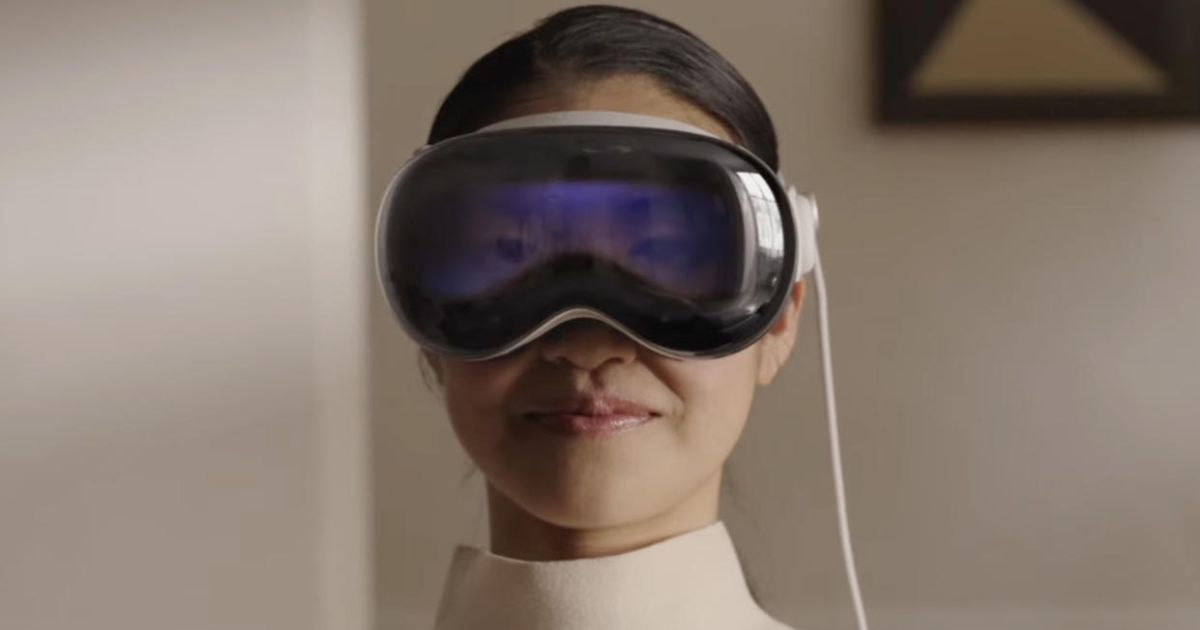Apple’s Vision Pro headset marks a groundbreaking step in the world of augmented and virtual reality (AR/VR). As one of the most anticipated products in recent years, this device is set to redefine how we engage with digital environments.
Leveraging Spatial Computing and Mixed Reality, Apple’s Vision Pro blends the digital world with the real world seamlessly, creating a highly immersive experience that stands apart from anything currently available.
With Ming-Chi Kuo, a trusted industry analyst, shedding light on the upcoming features, this headset promises not only to bring technological innovations but also to position Apple as a leader in the growing AR/VR Industry.
Kuo’s insights on the release timeline in February and detailed analysis of the technical specifications give us a clear picture of what to expect.
Key Technological Breakthroughs

The Apple Vision Pro is built on cutting-edge technology that sets it apart from competitors like the Meta Quest Series.
At the heart of this innovation is the Micro-OLED Display technology, which offers incredibly vibrant visuals and 4K Displays with unparalleled Pixel Density.
This high-performance display is paired with Advanced Tracking Systems that include LiDAR sensors, enabling precise depth-sensing capabilities.
These Depth-Sensing Technologies are crucial for applications such as Medical Visualization and 3D Modeling, making the Vision Pro a versatile tool for professionals.
Additionally, the device is powered by Apple’s proprietary M2 Chip and R1 Chip, providing robust performance and lightning-fast processing capabilities, ensuring a smooth and uninterrupted user experience.
Click Here For More Blog’s: Frankie Lymon Height: Exploring the Truth Behind the Legend
Technical Prowess: The Heart of Vision Pro
At the core of the Vision Pro’s technical prowess is its Thermal Management System. This ensures that the headset operates efficiently even during extended use, preventing overheating—a common issue with high-performance devices. Furthermore, the Field of View (FoV) in the Vision Pro is exceptionally wide, offering users a more natural and expansive view of their virtual surroundings.
Combined with Spatial Audio, the headset delivers an immersive sound experience that perfectly complements its visual outputs.
Apple’s attention to detail in Industrial Design and Aesthetics makes the Vision Pro not only a powerful tool but also a desirable accessory.
The sleek design, paired with lightweight materials, ensures comfort during prolonged wear.
Market Strategy: February Release and U.S. Launch
The launch of Apple Vision Pro in February is not just a product release—it’s part of Apple’s larger Market Strategy to dominate the U.S. market. Apple’s ecosystem is already deeply ingrained in the lives of millions of users across the U.S., making it easier for the Vision Pro to gain traction among early adopters.
Apple’s marketing strategy focuses on positioning the device as a premium offering, aimed at tech enthusiasts and professionals willing to invest in cutting-edge technology.
With Premium Pricing, Apple aims to differentiate itself from competitors like the Meta Quest Series. This pricing strategy ensures that the Vision Pro is positioned as a high-end product, appealing to those who demand the best in AR/VR technology.
Additionally, Apple’s Developer Ecosystem plays a significant role in expanding the device’s content availability, which will be crucial for long-term adoption and market success.
Versatile Applications: From Professional Tasks to Home Entertainment
One of the most exciting aspects of the Vision Pro is its versatility. The device isn’t just a headset; it’s a powerful platform that can cater to a wide range of Applications.
Professionals can use it for Medical Training, Virtual Laboratories, and Remote Collaboration Tools, thanks to its Advanced Tracking Systems and High-Resolution Displays.
On the other hand, Immersive Gaming and Interactive Storytelling open up new realms of entertainment at home. The combination of Spatial Computing and Virtual Reality enables engaging experiences that blur the line between fiction and reality.
The Vision Pro’s potential is limitless—whether it’s for Virtual Meetings, 3D Modeling, or even Healthcare Applications.
Competitive Landscape: Vision Pro vs. Meta’s Quest Series
When compared to Meta’s Quest Series, the Vision Pro holds distinct advantages. Meta’s Quest relies on a different approach, with less emphasis on Mixed Reality and more focused on standalone VR experiences.
While the Quest offers affordability, the Vision Pro targets a more premium segment, providing Advanced Tracking Systems and Micro-OLED Displays that far surpass what the Quest can offer.
Apple’s Apple’s Ecosystem further strengthens its position in the market. From seamless integration with Apple Watch and other devices to robust Developer Adoption, the Vision Pro is designed to function cohesively within Apple’s larger platform.
This ecosystem advantage makes the Vision Pro more than just a headset—it’s a comprehensive tool that enhances productivity and entertainment alike.
Challenges and Future Outlook
Despite its numerous strengths, the Vision Pro isn’t without its challenges. One of the primary concerns is Market Adoption.
The AR/VR industry is still in its infancy, and consumer Social Acceptance could take time. Additionally, while Apple’s Premium Pricing may attract early adopters, it may limit broader consumer appeal.
Apple must also focus on Content Availability—ensuring that developers create applications that fully utilize the headset’s features. If Apple can overcome these hurdles, the future outlook for Vision Pro is incredibly promising.
With continuous Technical Specifications updates and enhancements, this device has the potential to redefine how we experience augmented and virtual realities for years to come.
FAQ,s
What is the Apple Vision Pro, and why is it significant?
The Apple Vision Pro is a mixed reality headset that represents Apple’s first major entry into spatial computing and immersive technology.
According to Ming-Chi Kuo’s insights from Wccftech, this device blends augmented reality (AR) and virtual reality (VR) in ways that create seamless digital and physical experiences. Its combination of Micro-OLED Display Technology, Advanced Tracking Systems, and Spatial Audio makes it a significant milestone in AR/VR technology.
What are the key technological features of the Vision Pro?
The Vision Pro features several groundbreaking technologies:
- Micro-OLED Display Technology: Dual 4K displays with unparalleled pixel density and clarity.
- Advanced Tracking Systems: Eye tracking, hand recognition, and facial mapping using LiDAR and depth-sensing technologies.
- Processor: Powered by the M2 and R1 chips, which handle complex spatial computing tasks with real-time processing.
- Spatial Audio: Adapts to head movement, creating a dynamic sound experience that enhances immersion.
How does Apple plan to position the Vision Pro in the U.S. market?
Apple’s market strategy, as analyzed by Kuo, includes a phased rollout starting with early adopters in the U.S. market. Initial production will be limited to 60,000-80,000 units in the first quarter. The focus on the U.S. allows Apple to refine user experiences, foster developer momentum, and build strong support systems before gradually expanding globally.
What are the primary applications of the Vision Pro?
The Vision Pro is highly versatile, with applications across multiple industries:
- Professional Use: 3D modeling, virtual meetings, medical visualization.
- Entertainment: Immersive gaming, virtual cinema, interactive storytelling.
- Education: Virtual labs, interactive learning environments.
- Healthcare: Medical training, patient education, and surgical planning.
How does the Vision Pro compare to competitors like the Meta Quest series?
Unlike Meta’s Quest series, which targets the mid-range market with a focus on gaming, the Vision Pro is positioned in the premium segment with a focus on professional and industrial applications. The Vision Pro’s price point is higher, starting at $3,499, reflecting its premium features and advanced capabilities.
What challenges could affect the adoption of the Vision Pro?
Key challenges include:
- Battery Life: Currently limited to 2 hours, which may require external battery packs.
- Market Adoption: The premium pricing could limit broader appeal, and social acceptance of mixed reality devices might take time.
- Content Availability: The success of the device heavily depends on the developer ecosystem and content availability to ensure long-term engagement.
What future impact will the Vision Pro have on various industries?
The Vision Pro’s innovations in spatial computing, display technology, and human-computer interaction will likely influence industrial design, architecture, healthcare, and education. It sets a foundation for immersive computing that will shape how industries approach digital collaboration, training, and visualization.
Conclusion
The Apple Vision Pro headset is more than just a device; it’s a technological milestone that sets new standards in AR and VR technology.
With Ming-Chi Kuo’s insights and Apple’s innovative approach, this device is poised to lead the way in immersive computing.
From its advanced Display Technology to its wide Field of View and integration of Spatial Audio, the Vision Pro promises an unparalleled experience.
As it makes its way into the U.S. market in February, Apple is sure to capture the attention of early adopters and tech enthusiasts alike.
The Vision Pro’s versatility, combined with Apple’s ecosystem and commitment to Developer Adoption, ensures that this headset is more than just a product—it’s the future of augmented and virtual reality.
Click Here For More Blog’s:

As the admin ofrealwaving.com, I am dedicated to curating and delivering reliable content on general topics. Passionate about addressing key queries, I strive to provide clear, concise, and engaging answers to ensure readers find solutions to their most important questions effortlessly. Your curiosity inspires our journey to knowledge.
